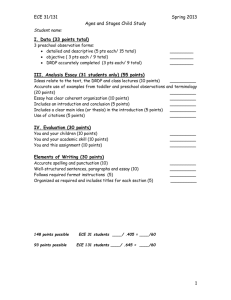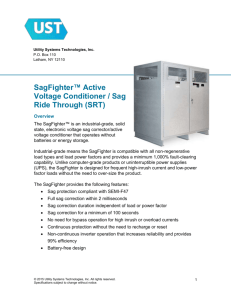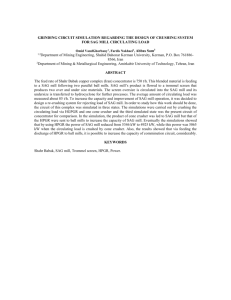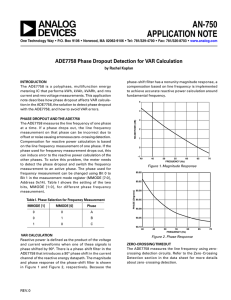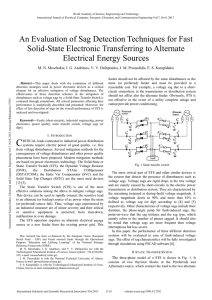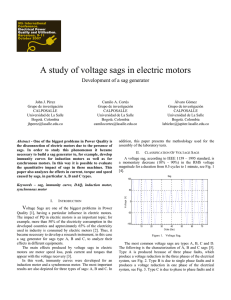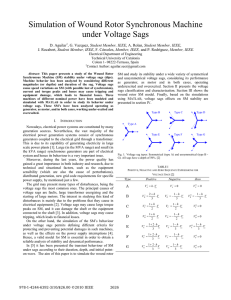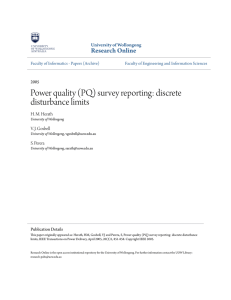ECE 528 Exam 1 This is a “take home” exam. It is considered “open
advertisement
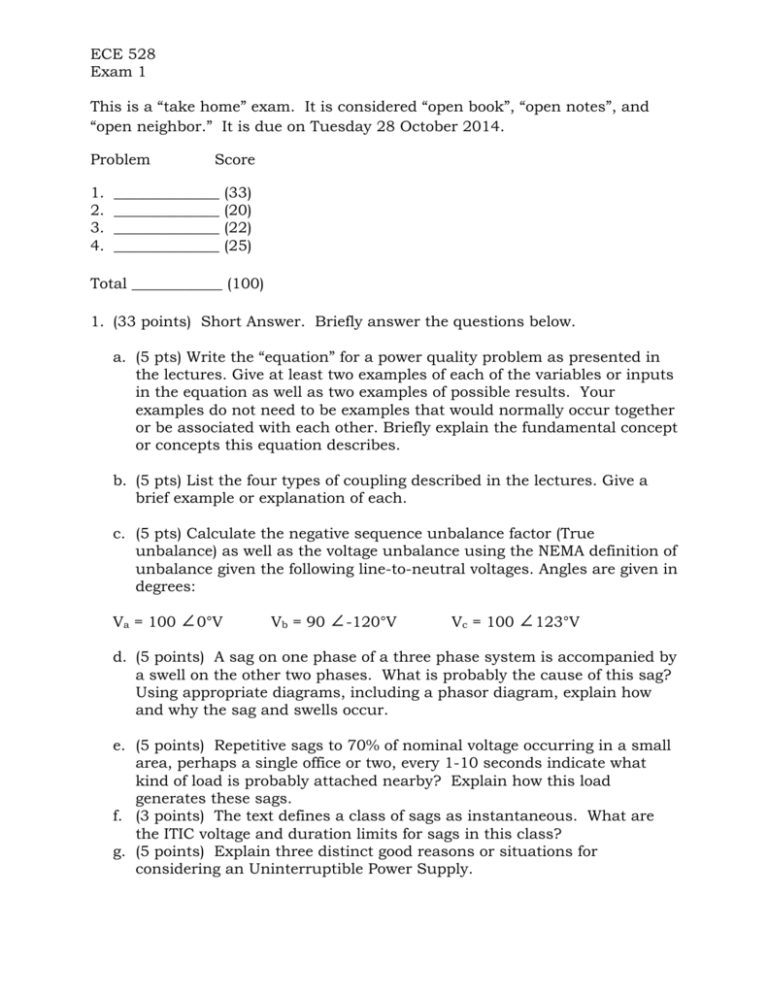
ECE 528 Exam 1 This is a “take home” exam. It is considered “open book”, “open notes”, and “open neighbor.” It is due on Tuesday 28 October 2014. Problem 1. 2. 3. 4. Score ______________ ______________ ______________ ______________ (33) (20) (22) (25) Total ____________ (100) 1. (33 points) Short Answer. Briefly answer the questions below. a. (5 pts) Write the “equation” for a power quality problem as presented in the lectures. Give at least two examples of each of the variables or inputs in the equation as well as two examples of possible results. Your examples do not need to be examples that would normally occur together or be associated with each other. Briefly explain the fundamental concept or concepts this equation describes. b. (5 pts) List the four types of coupling described in the lectures. Give a brief example or explanation of each. c. (5 pts) Calculate the negative sequence unbalance factor (True unbalance) as well as the voltage unbalance using the NEMA definition of unbalance given the following line-to-neutral voltages. Angles are given in degrees: Va = 100 ∠ 0°V Vb = 90 ∠ -120°V Vc = 100 ∠ 123°V d. (5 points) A sag on one phase of a three phase system is accompanied by a swell on the other two phases. What is probably the cause of this sag? Using appropriate diagrams, including a phasor diagram, explain how and why the sag and swells occur. e. (5 points) Repetitive sags to 70% of nominal voltage occurring in a small area, perhaps a single office or two, every 1-10 seconds indicate what kind of load is probably attached nearby? Explain how this load generates these sags. f. (3 points) The text defines a class of sags as instantaneous. What are the ITIC voltage and duration limits for sags in this class? g. (5 points) Explain three distinct good reasons or situations for considering an Uninterruptible Power Supply. ECE 528 Exam 1 2. (20 points) One way to reduce the severity of effects resulting from oscillatory voltage transients on a line that feeds an Adjustable Speed Drive is to insert series inductors. Consider such a drive supplying a motor load. The drive’s three phase diode rectifier faces the line. The drive’s load appears to the dc link as a constant direct current providing the drive with 5.0kW. The source voltage provided by the utility is 220V line-to-line at 50 Hz. The source impedance may be assumed to be all inductive. Without any added inductors, the short circuit MVA at the drive terminals is 1.25 MVA. In series with the drive, we add an inductive reactance that is 5% on the 5.0 kVA, 220V, 50Hz base. a. (5 points) If a nearby capacitor switching operation creates the transients, state a typical value for the peak voltage on the oscillatory transient. b. (10 points) Find the peak terminal voltage at the line side of the added series inductance. c. (5 points) For extra protection of the drive against transients like this, would a crowbar circuit or a clamp circuit be a better choice? Why? 3. (22 points) In the distribution feeder illustrated in figure 1. L1 is a singlephase fused tap, and L2 is a three-phase fused tap. Fuse sizes are shown on the diagram. The fuses on L2 are 100T fuses. There is a recloser “R” located downstream of L1, and upstream of L2 as shown. The recloser is set up for fast-tripping (fuse-saving) operation. It is programmed for two fast and two slow operations. The first reclose interval is 5 seconds, and the second and third intervals are 10 seconds each. Only a small percentage of the feeder’s load is beyond this recloser. Assume a 3-phase temporary fault occurs on tap L2, well beyond the fuses, with a three-phase fault current of 900A. The fault clears itself 13 seconds after it starts. Use the attached time-current curves in Figure 3 to determine the following: a. (12 pts.) The number and duration of interruptions that customer C experiences. b. (10 pts.) What type of disturbances does customer A experience? How many and how long are these disturbances. ECE 528 Exam 1 Figure 1. Distribution system 4. (25 points) Consider the simple network shown in Figure 2. A 50 Horsepower, 230V induction motor is connected to a 13.8 kV (line to line) three phase bus. The bus is considered to be very stiff. The impedance of the utility beyond that transformers can be considered to be negligible. The motor has a peak starting current of 630 Amps per phase when tested as shown. The 13.8kV/480V transformer supplying the plant has a series reactance of 7.5%. Inside the plant, the 480V:230V transformer supplying the motor has a series reactance of 4.0% and a 480V:120V transformer supplying the equipment at the neighbors’ has a series reactance of 4.5%. Everything is on the same consistent per unit base system for this problem; no transformation of bases is necessary. You may work in per unit. 13.8kV:480V Z = 7.5% 480V:230V Z = 4.0% m (Motor Load) 1.0 per unit voltage Neighbors 480:120V Z = 4.5% Figure 2. Distribution System a. (10 points) If the equipment at the neighbors’ is a resistive load running in steady state at 75% of base current, find the depth of the sag that the equipment at the neighbors’ will experience when the motor is started. State clearly a reasonable assumption about the power factor of the induction motor under starting conditions. ECE 528 Exam 1 b. (5 points) Specify a method to reduce the sag at the neighbors’ to within ITIC limits for a sag of up to three seconds’ duration. Include enough information and numbers to allow enable us to predict what the sag should be. You may keep this proposed improvement quite simple. c. (10 points) Predict the depth of the sag at the neighbors’ for your sag reduction method. ECE 528 Exam 1 Figure 3. Fuse curves.

